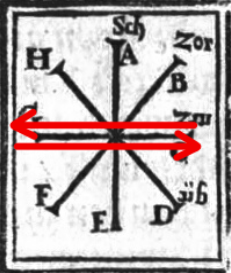Zwerch
| Line 13: | Line 13: | ||
[[File:zwerch.png | center]] | [[File:zwerch.png | center]] | ||
| + | |||
| + | ==Application== | ||
| + | |||
| + | The basic zwerch described moves around in a broad overhead movement, but the zwerch need not go all the way around the head in a looping movement ([[Rinde]]). More often we use a tight zwerch motion. For example, from an [[ochs]] on the right side the fencer can step to the right and move the blade around in a tight loop through [[Einhorn]] and back down to cut a short zwerch to the opponent's left ear. | ||
| + | |||
| + | The zwerch can also be used diagonally instead of horizontally, and flitting over ([[Verfliegen]]) to the opposite diagonal opening is a common use for the zwerch. | ||
| + | |||
| + | Meyer also uses the zwerch as one of his generic withdrawing movements through the [[Stages of the Exchange]], providing a threat with a cut, and danger from the point, and protecting against strikes from above. | ||
==Application Example== | ==Application Example== | ||
Revision as of 01:29, 29 June 2016
Contents |
Thwart
On of the five meisterhauw, the zwerch breaks vom tag and counters the zornhauw/oberhauw.
Execution
The zwerch is a strike performed with the hands high ending almost in an ochs position. The easiest way to imagine a zwerch is to stand in ochs rechts (left leg forward), thumb under the blade. Keeping the hands up high and the thumb under bring the sword around overhead like a helicopter blade, stepping forward with the right and ending basically in left ochs. Once mastered this helicopter action can be greatly reduced into tighter cuts.
Zwerch can also be performed on diagonal lines to all of the openings, and is particularly deceptive in this case.
When used to counter a zornhauw the fencer steps in, catching the zornhau on the crossguard and simultaneously striking to the opponent’s upper left opening.
Application
The basic zwerch described moves around in a broad overhead movement, but the zwerch need not go all the way around the head in a looping movement (Rinde). More often we use a tight zwerch motion. For example, from an ochs on the right side the fencer can step to the right and move the blade around in a tight loop through Einhorn and back down to cut a short zwerch to the opponent's left ear.
The zwerch can also be used diagonally instead of horizontally, and flitting over (Verfliegen) to the opposite diagonal opening is a common use for the zwerch.
Meyer also uses the zwerch as one of his generic withdrawing movements through the Stages of the Exchange, providing a threat with a cut, and danger from the point, and protecting against strikes from above.
Application Example
In which the 'student' demonstrates their knowledge to the 'teacher'.
| Teacher | Student |
|---|---|
| Zornhut, left leg forward | Zornhut, left leg forward |
| Passing Step Zornhauw | Passing Step forward and right |
| Zwerch, catching blade on crossguard, Triangle Step with rear leg to face toward the teacher. |

